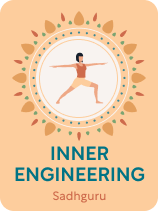

This article is an excerpt from the Shortform book guide to "Inner Engineering" by Sadhguru. Shortform has the world's best summaries and analyses of books you should be reading.
Like this article? Sign up for a free trial here.
Can we control our thoughts? Do our thoughts come from within ourselves or from the external world?
We tend to think of thoughts as products of our external circumstances, and therefore being out of our control. But in reality, you are the one who generates the thoughts, observes the thoughts, and suffers from the thoughts, and it’s within your power to control them.
Here’s why you don’t have to live at the mercy of your thoughts, according to yogi Sadhguru.
Taking Charge of Your Thoughts
One of the main problems with the human mind, according to Sadhguru, is that instead of being in control of our own thoughts, we allow them to control us. Because we allow ourselves to be at the whim of our emotional states, we try to arrange the world around us to create circumstances that make us feel good, rather than directing our own minds and feelings. This is always precarious, he says, because there’s so much in life that we can’t control.
Sadhguru asks: How can your own thoughts make you miserable when you generate your thoughts? Why would you do that to yourself? And yet, he points out, we have thoughts that constantly make us suffer. You need to learn to be in charge of your own mind, instead of allowing your mind to control you. Sadhguru says practicing yoga will help you recognize the distinction between you and your mind.
You perceive them as products of your external circumstances, but Sadhguru says you need to recognize that all of your experience is generated within you. You think someone is “making” you angry, or your job “makes” you stressed. But, while that person or job may be what triggers these states, the anger and stress are inside you, and therefore you’re generating these feelings, and you can choose not to.
Sadhguru says the concepts of “stress management” and “anger management” assume those are inevitable facets of our lives that we must learn to manage. This is a false assumption. He says we don’t need to accept these as inevitable—we can totally eliminate them from our lives. It’s simply a matter of how we respond to situations.
So, Sadhguru says you must move from being a passive victim of circumstance to an active master of your own life. This means making a shift from being “reactive” (having an unconscious reaction) to being “responsive” (having a conscious response). In other words, making conscious choices about how to be in every moment.
| Can We Control Our Thoughts and Emotions? In The Happiness Trap, Russ Harris argues that we really can’t control our thoughts and emotions and that it’s unproductive or even unhealthy to expect anyone to do so. He says the “myth” that we can control our thoughts and emotions is one of the traps people fall into that keep them stuck in unhappiness because it only leads to emotional repression and ultimately a feeling of failure when we can’t achieve it. On the other hand, countless yoga practitioners claim to be able to do exactly that, with consistent practice. So, the truth probably lies somewhere in the middle—it’s certainly not easy to learn to control your thoughts and emotions, but neither is it impossible. In the Yoga Sutras, Patanjali described this as being able to minimize the “ripples” of thoughts that disturb the stillness of our minds. The key lies in this distinction between your “self” and your mind, or what is sometimes referred to as the thinking mind and the observing mind. In Buddhist meditation practice (as well as in the yoga Sadhguru teaches), making this distinction is crucial, because when you realize your thinking mind is not you—you are the one observing the thoughts—you can learn to distance yourself from those thoughts. And putting this distance between your mind and your self allows you to detach from the emotions that arise from those thoughts as well. |

———End of Preview———
Like what you just read? Read the rest of the world's best book summary and analysis of Sadhguru's "Inner Engineering" at Shortform.
Here's what you'll find in our full Inner Engineering summary:
- An introduction to the science of yoga and its transformative powers
- Renowned yogi Sadhguru's journey of self-discovery
- Why yoga is not meant to be an exercise or a way to get "fit"






